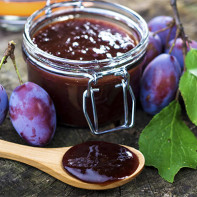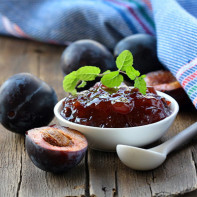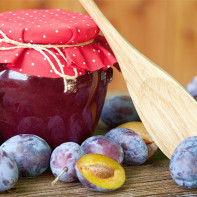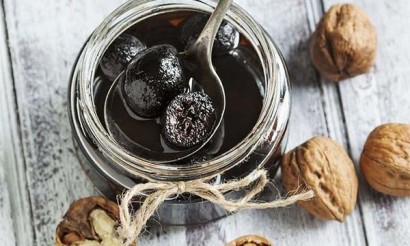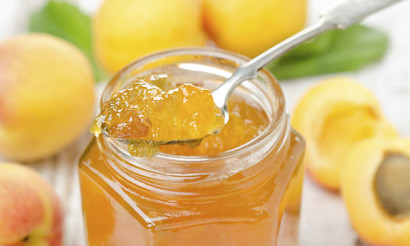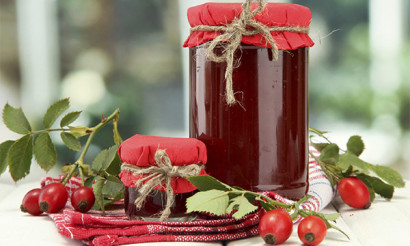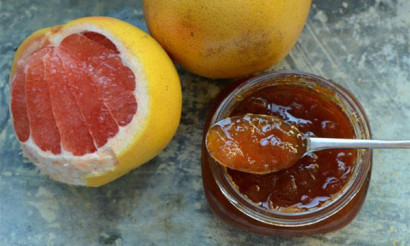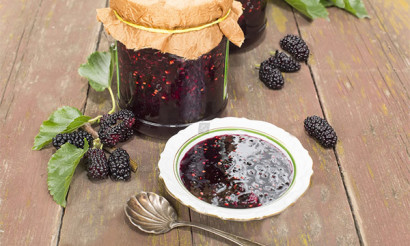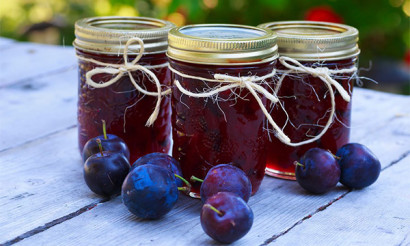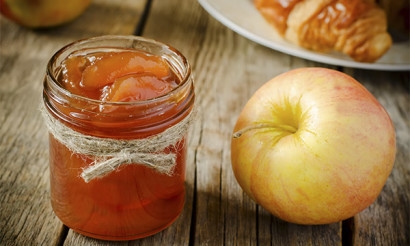Plum jam: 16 recipes
No garden plot is without home-made plums. It is not as ornate as a pear or apple and does not lure in sweetness like a cherry, but the owners look forward to its ripening. For some, the plum becomes the material for a delicious homemade tincture, while others simply lick themselves in anticipation of jam or compote. Unfortunately, plums don't keep for long, and a rich harvest brings the hassle of processing them. Plums can be frozen, but this is rarely used. After defrosting, it loses its attractive appearance and turns into an unappetizing mush. Most often it is dried and preserved as a compote. The most popular way was and remains the preparation of jam. There are many recipes. Those who are not yet familiar with this variety, it is worth cooking everything and a little bit, in order to appreciate the taste personally.
- Composition and calories
- What is useful for plum jam
- How to choose plums for jam
- How to cook plum jam: Recipes
- Five-Minute
- With Bone
- Classic recipe
- pitted
- With Walnuts
- With Cocoa
- With yellow plums
- With apples
- With pears
- With lemon
- With cinnamon
- With orange
- Pumpkin
- Thick jam
- With Cognac
- For Diabetics
- How to store the finished product
- Interesting Facts about Plums
Composition and calories
The history of the appearance of the plum is shrouded in mystery. In the wild, it is practically not found. Scientists crossed cherry plums and thorns to obtain a domestic version. Many botanists are inclined to conclude that this happened in nature as well, only naturally, especially since the growth areas of thorns and alycha almost coincide.
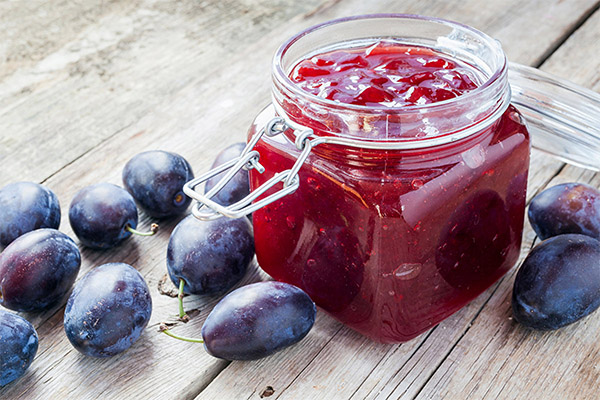
Interesting: Thorns are often referred to as wild plums.
In any case, the cross-breeding experiment was a success. Breeders began to develop it, breeding more and more new varieties, differing in size and color, level of sweetness and ripening time. The composition of all varieties is almost the same, differing in fruit sugars and vitamins. Plums contain:
- vitamins A, E, PP, C, B;
- polyphenols;
- fiber;
- potassium;
- magnesium;
- iron;
- anthocyanins;
- organic acids;
- pectin.
Calories are low, only 49 kcal per 100 grams of product. Plum is recommended in dietary diets to accelerate the withdrawal of toxins and normalize digestion.
It is worth taking into consideration: Scientists have not yet determined the identity of the plum. The debate is between the definitions of "fruit" and "berry. While spears are being broken in scientific disputes, owners of garden plots take a basket or a bucket and gather a harvest of fragrant fruits, the good thing is that plums bear fruit for 10-15 years annually.
What is plum jam good for?
With minimal heat treatment almost all the useful substances and properties of fruit are preserved.
Plum has a mild laxative effect, which is very important for people who suffer from digestive system disorders. It is recommended to eat 3-4 large fruits every day to those who are diagnosed with hemorrhoids, as well as with the general slagging of the body.
- Vitamin complex and calcium in the fruit strengthens bone tissue, keeping its density in old age, prevent the development of osteoporosis.
- The fruit of the plum tree is known as a powerful antidepressant, even the aroma of ripe plums can put you in a good mood and relieve impending depression.
- Several plums a day speed up regeneration and strengthen the immune system, which allows you to survive the time of seasonal epidemics without coughing and stuffy nose.
- The pulp of ripe fruits helps the absorption of iron and improves blood values, regulates its clotting, accelerates the formation of red blood cells.
Regular use of fresh or dried fruit significantly slows the aging process, relieves the acuteness of menopausal syndrome, speeds up the metabolism and removes free radicals. Plum is recommended for preserving visual acuity, restoring memory capacity, increasing the stability of attention, eliminating skin problems, reducing the risk of cancerous tumors.
How to choose plums for jam
In the process of long-term work, breeders have bred a large number of varieties, sometimes little resembling the ancestor, a small oval plum of blue-blue hue with fibrous flesh and almost no separable bone. Now the palette of colors ranges from almost white, golden to burgundy and dark blue. The size also varies from giants to very miniature varieties, more reminiscent of thorns. For cooking it is not the color and size that are particularly important, but whether or not the pit separates from the pulp.

For the preparation of winter stocks, it is better to choose domestic varieties, recently plucked from a branch. The product, brought from afar, most often harvested unripe. It tastes like a dishwashing sponge. Such fruits will not be especially juicy and flavorful, and will not fetch a good price. During the season, there is an abundance of plums of all varieties and hues at collective and farmers' markets. Most often on the counters are found these varieties:
- Anna Speth.
- Hungarian.
- Russian golden.
- Honey.
- Firefly.
- Short-fruited.
- Red-breasted Large.
- Morning.
- Volga Beauty.
In order to choose a plum for jam, you need to decide on a recipe. There are a lot of them in people's treasuries and cookbooks, and one chooses the fruit according to the planned result. For example, to boil in halves you need the pit to separate easily from the pulp, but to make jam or marmalade this is insignificant. Afterwards you will have to grind the mass to remove the skin anyway, and at the same time the pips will get out.
For a dressy holiday version, you can take two varieties of different shades. The bright golden color in the process of cooking will be replaced by a more gentle, but the difference in color of dark and light species will remain.
The main criteria for selection are:
- freshness of the product;
- Uniformity of color of fruit without dark spots and dents;
- Absence of a tartar smell.
Likewise, the firmness of the flesh: too firm indicates that the fruit is unripe, while a soft, supple surface under the fingers indicates that the plum is overripe or has lain too long after being picked from the branches.
For jam need only ripe fruit, then they generously give juice and will not give astringent taste.
How to boil plum jam: recipes
The delicacy is prepared in the classic way and with the addition of various ingredients.

It is worth taking into account: Plum refers to sour fruit, even the sweetest variety requires an increased amount of sugar.
Five-Minute
The most useful jam, preserving the maximum number of vitamins and trace elements. The essence is to boil the fruit mass and immediately seal it in jars. Such a treat is delicious and useful, but they should not get carried away, unless you want to get an upset stomach. At 1 kg of fruit take 1.4-1.5 kg of sugar. Ingredients are placed in layers in an enamel or ceramic bowl and leave in the heat for 2 hours.
As soon as the juice appears, transfer the mixture to a saucepan with a thick bottom and put on the fire. After boiling, the mass is kept for 5 minutes with constant stirring, removing the foam as it forms. Then set the mass aside until it cools completely. During this time, prepare and sterilize jars. Cooled jam once again bring to a boil and quickly spread out in containers.
With a bone
In plums, the pit is not bitter and does not affect the taste of the finished product. When cooking you can go two ways: leave the pips or take them out by rubbing the cooked mass through a sieve or colander. When cooking with the bone, there is no need to be very picky about the choice of variety, you can cook what you have.
A classic recipe
The easiest way to try your hand at the classic, where no special culinary talents are required. The preparation is extremely simple. Fruits and sugar are taken in equal proportions. For 1 kg of plums you will need to add 100 ml. water. In order not to wait for the juice to appear, it is easier to boil sugar and water, pour this syrup over the halves of fruit and put to simmer on very low heat for about 40-50 minutes. Be sure to stir the mass regularly, so that it does not stick. It is more convenient to do this with a wooden spatula. It does not crush the berries and mix the contents of the pot well. The foam is constantly removed, so that the jam turned out one-colored.
It is worth noting: mass quickly thickens as it cools, so spread it out into jars immediately after boiling.
Seedless
If your goal is to make aesthetically beautiful jam from even halves or quarters, you should hit the market in search of varieties with fruit that can be opened neatly without cracking and where the pips are well separated from the pulp. Thus, you should pay attention to such varieties:
- Renclode.
- Volga beauty.
- Zarechnaya early.
- Hungarian Moscow.
- Ochakovskaya yellow.
In order to keep the slices in shape and not to break apart, use recipes with a pre-pouring of boiling syrup.
With walnuts
The secrets of this jam have several:
- use any nuts, not only walnuts;
- Select a slightly unripe or hard plum variety;
- Pre-soak the nuts for 30 minutes;
- Too big nuts are chopped with a knife into small pieces;
- Exactly maintain the time of cooking, otherwise you will get fruit and nut paste.
First boil the plums, 10 minutes after boiling add sugar at the rate of 1:1 with the amount of fruit. Cooking time is 30 minutes. Then, take the nuts out of the water and put them in a colander to drain the excess liquid. After adding them to the boiling mass, turn off the fire in exactly 15 minutes. The finished delicacy is immediately placed in containers for storage and hermetically sealed.
It is worth noting: Very beautiful looks a treat of quarters of plums with walnuts, also divided into 4 parts.
With cacao
This ingredient gives the dessert a light chocolate flavor. The product is quite finicky and for preservation, the ready mass is placed only in dry, oven-sterilized jars. Cooking goes with the classic recipe, it is better to choose late varieties with a well detachable bone. For 1 kg of fruit take 500 grams of granulated sugar and 1 tsp. spoonful of cocoa.
Fill plums with half the sugar and let stand until a juice, then boil, add the remaining sugar, cocoa and if desired 1 bag of vanillin. The mass is boiled for 40 minutes with constant stirring, spread in jars while hot.
From the yellow plum.
For most people, plum is associated with a blue or almost black color. The yellow varieties are bred through selection. They are not as sour, are larger, and are great for making winter stocks. The jam turns out stunningly clear and amber in color and has a subtle, slightly sour taste. The level of sweetness can be adjusted to taste by adding or reducing the percentage of sugar.
Prepared according to the classic recipe with a single boil, or with syrup pouring if you want to keep the plum slices uncooked.
With apples
Late varieties are perfectly combined with autumn apples. Choose varieties with sweet juicy flesh. The easiest way is to combine 700 grams of apple slices, 600 grams of plums divided into halves with the bone removed, and 1 kg of sugar. All the ingredients are poured into a saucepan and left for 1-2 hours. When the juice appears, put it on the stove. The mass is boiled for 40 minutes, regularly removing the foam. Then the finished product is packed in small jars. If you plan to store them in a cool place, then close the dainty covered with tight polyethylene lids.
A very interesting variant is made of early plums with runny apples. The plum mass is boiled into a mashed potato, and small whole apples shine with their sides in it. To get the juice, they are stabbed with a needle on 2-3 sides before boiling, and the stalks are left. Children especially like this treat when, pulling the twig, they pull out of the sweet mass of an apple.
With pears
The recipe involves the classic way of cooking. Pears are divided into 4-8 slices, the middle with seeds are removed. Plums are divided into halves, removing the bone. Proportions:
- fruits - 500 g each;
- water - 200 ml;
- sugar - 1 kg.
Cooking time is 35-40 minutes.
With lemon
A very interesting combination of 2 flavors, when the flavor of plums is overlaid with a citrus touch. You will need 1.5 kg of plums, the same amount of sugar, 100 ml of water and the juice of half a large lemon with a thick skin. Small elongated fruits look original in this jam. The pit is removed from them with the back of a pencil or sushi stick, pushing it inside. In this way, the fruit looks intact, peeking through the thin glass of the jar.
Pour boiling syrup over the plums and simmer for 30 minutes with continuous stirring. Lemon juice is added to the boiling mass, boil the mixture for another 10 minutes. We get about 2 liters of jam and more rosettes for tasting.
With cinnamon
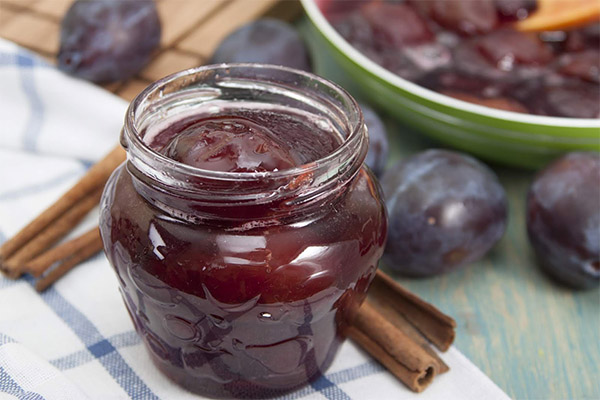
The jam is prepared in the classic version with the observance of the proportions 1:1, at the end of cooking in the boiling mixture add cinnamon. The secret is to use a spice of high quality. For 2 kg of fruit you need only 1 stick of cinnamon or ground spice in the amount of 3-5 grams. It gives a delicacy subtle spicy taste. It goes well with lemon or orange juice in jam.
With orange
Plum and sugar are taken in equal proportions, to them add 1 large orange. It is peeled off the zest, and the septa, which gives bitterness in the finished product, are removed from the slices.
Slow heating in the syrup will leave smooth slices of plum, with a rapid boil you get jam. Orange slices are cut into 3-4 pieces. First boil the plums, then add the orange and boil for 30 minutes. Ready jam packed and put away for storage.
With pumpkin
Pumpkin is used to make soups, main courses, pie fillings and desserts. Paired with plums, they produce an unusual and very attractive flavor. For cooking, they are peeled not only from the bone, but also from the skin. The pumpkin is grated on a coarse grater. Ingredients are taken in equal proportions - 600 g each, the amount of sugar is increased by 1\4 if you got too sour plum fruit.
The cooking time varies depending on the type of pumpkin. The main sign of readiness of the delicacy is the complete softening of the pumpkin shavings. Five minutes before it is ready, add 0.5 tsp. cinnamon to the mass or omit one cinnamon stick.
Thick jam
For those who like a sweet bun with jam in the morning, one of the simple recipes will come in handy. To make the jam thick, it is cooked with observance of the traditional proportions, but increase the boiling time. Plum is perfectly gelled, so the mass thickens as it cools. Therefore, it is poured immediately after cooking and in small jars, so that it was easier to take out with a spoon.
With cognac
It is impossible to spoil this recipe. It is based on an ordinary jam made of any kind of plums in the ratio of ingredients 1:1. The secret addition is cognac 5 minutes before it is ready. It is clear that the cognac itself is much better than in the jam, but it is still worth sticking to the recipe. The mixture is boiled in three approaches of 10 minutes each with complete cooling in between to reveal flavor. Cognac is added at the last approach. By the way, very tasty will turn out if you add a bar of quality chocolate in small pieces together with 1 tbsp of the noble beverage. In this case, the dessert is considered ready when the chocolate has dissolved completely. The delicacy is immediately removed from the stove and poured into small shaped jars. Sealed hermetically to preserve the unique flavor.
For diabetics
Restriction on the use of sugar is not a reason to give up all the goodies. Jam is quite successfully cooked on sugar substitutes. They become:
- xylitol;
- sorbitol;
- stevia;
- Maple syrup.
A very interesting variant is obtained by boiling plums in grape juice, but for obtaining permission for such a dessert will have to go to the attending physician.
It is worth remembering: sweeteners do not thicken, so the jam will turn out liquid. It can be boiled down to the state of jam, or add thickener "Sladis", approved for diabetics.
If you do not want to risk it, it is worth cooking plums without sugar in their own juice and diversify your diet in winter with a pleasant sourness.
How to store the final product
The shelf life of jam is at least one year. With a longer storage it will not go bad, but will lose all its useful properties. Well boiled, it will perfectly stand in the corridor or in a wall cupboard in the corner of the kitchen. It is better to store the five-minute plums in the refrigerator or cellar.
Interesting facts about plums

- Plum flowers symbolize the rebirth of life.
- The life span of the tree reaches 30 years, but the fruiting ends in 15.
- On the Balkan Peninsula there is a belief that whoever has planted a plum tree is forgiven all his sins.
- Among the variety of varieties, the most popular is the house plum. It accounts for 90% of the trees.
- The fruit and leaves are used in folk medicine because of their laxative, antipyretic and decongestant effects.
Plum jam is hugely popular and has many flavors. Any hostess can create her own signature recipe based on the classic version.
«Important: All information on this site is provided for informational purposes only purposes. Before applying any recommendations, consult a professional specialist before applying any of the recommendations. Neither the editors nor the authors shall be liable for any possible harm caused by materials."

